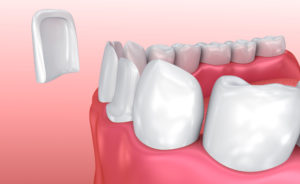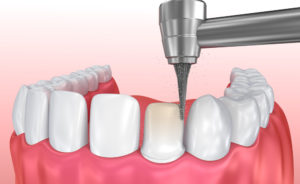Veneers: What You Need to Know
Many people are familiar with the term “veneers” when it comes to cosmetic dentistry. In our age of information, it is difficult to know what actually applies to you when it comes to cosmetic dentistry. One of the most important things to understand is that there are different types of veneers, which this blog will cover.
What is a Veneer?
The term veneer is actually fairly generic. It simply means a covering. You may have heard the term used to describe kitchen cabinets as having a “wood veneer”. That means the cabinets themselves are not made from wood, and they have a thin, outer covering to give them the appearance of wood.
The same applies to teeth. A veneer is a thin, outer covering to change the appearance of a tooth or teeth.
In general, dentists use veneers to cover multiple teeth and create cosmetic improvements in someone’s smile. Dental veneers cover the entire visible surface of teeth. This typically includes the side of a tooth facing the cheeks and lips and a portion of the biting edge.
What is a Porcelain Veneer?
A porcelain veneer is simply a dental veneer made from porcelain. In the dental world, porcelain is a glazed ceramic, which means it is the glossiest, shiniest material available.
Dental porcelain not only comes in every possible color of teeth; it is customizable. The dental lab technician is able to add tiny characterizations into the porcelain to make it look as “real” as possible. Notice, we said that the lab technician does this. An important aspect of porcelain veneers is that they are made by a dental lab technician. Click here to read about the awarded and highly acclaimed lab technician Dr. Ann and Dr. Lauren work with on all cosmetic cases.
Porcelain veneers are the “gold standard” in cosmetic dentistry. They provide the best light reflection (mimicking the glossiness of tooth enamel), and they are capable of making drastic changes to a smile).
What is a Composite Veneer?
A composite veneer is a veneer made from tooth-colored filling material called composite. This material is also available in many different tooth colors and is customizable. In a composite veneer, your dentist creates the veneer directly on your tooth. This is one of the biggest differences between porcelain and composite veneers. A composite veneer requires no lab time and no provisional veneers (temporarily covering the teeth).
 Composite veneers have a few disadvantages when compared to porcelain veneers. Although the material is polishable, they will not achieve the same level of shine and gloss as glazed porcelain. Many people feel that composite veneers have the appearance of being dull or lifeless. Also, being made directly in the mouth, they are susceptible to contamination by saliva or air bubbles, neither of which are a problem for porcelain veneers made in a lab.
Composite veneers have a few disadvantages when compared to porcelain veneers. Although the material is polishable, they will not achieve the same level of shine and gloss as glazed porcelain. Many people feel that composite veneers have the appearance of being dull or lifeless. Also, being made directly in the mouth, they are susceptible to contamination by saliva or air bubbles, neither of which are a problem for porcelain veneers made in a lab.
One great advantage of composite veneers over porcelain veneers is their repairabiilty. Because composite material will bond to itself, we can quickly and easily repair chips or cracks in a composite veneer. This is in contrast to porcelain veneers, which require complete removal and replacement if chipped or cracked.
Composite veneers are a little less expensive than porcelain veneers and are a great option for making minor changes to your smile!
Which is Better?
There is no easy answer to this question. Because we never take a “one-size-fits-all” approach to cosmetic dentistry, we do not attempt to answer blanket questions like this. However, once we perform a cosmetic evaluation of your teeth, then we can give you a specific answer.
There are advantages of each type of veneer, which can help us choose the one that would be better in your specific case.
Advantages of Porcelain Veneers
Porcelain veneers give a greater cosmetic change to the smile. If your goal is to cover and/or disguise deep discoloration or misalignment of the teeth, porcelain veneers are the better option.
The high gloss produced by glazed porcelain creates the sparkling, bright smile desired by many who are considering cosmetic changes with veneers.
The glossy texture of porcelain veneers makes them more resistant to staining. This means they will maintain their beautiful color for years and years without picking up ugly coffee, tea and tobacco stains.
Advantages of Composite Veneers
Composite veneers have the advantage of requiring only one visit. Because your dentist creates them, there is no waiting period on the lab work, and there is no need to wear temporary veneers.
Composite veneers are less expensive than porcelain veneers.
Composite veneers can be repaired throughout their lifetime, fixing minor chips and cracks.
I’m Not So Sure. Can I Try Before I Buy?
At Designer Smiles, we are thrilled to offer an option called “Trial Smile”. A trial smile is a cosmetic try-in of the proposed changes we can make with dental veneers. After a thorough interview process and evaluation of your current state, Dr. Ann and Dr. Lauren will work with the dental lab to create a model of your desired changes. Using this model, they can reproduce it on your teeth. We love giving you the ability to envision what your new smile will look like! We take photos and even videos showing you speaking, laughing, and smiling with your new smile.
Being able to see the changes dental veneers will make to your smile and your overall appearance enables you to make the best, most informed decision about your cosmetic dentistry options!
Do You Have Other Questions about Cosmetic Dentistry Options?
Call Designer Smiles to schedule a cosmetic consultation with Dr. Ann and Dr. Lauren. You can begin the journey to a beautiful new smile today!

